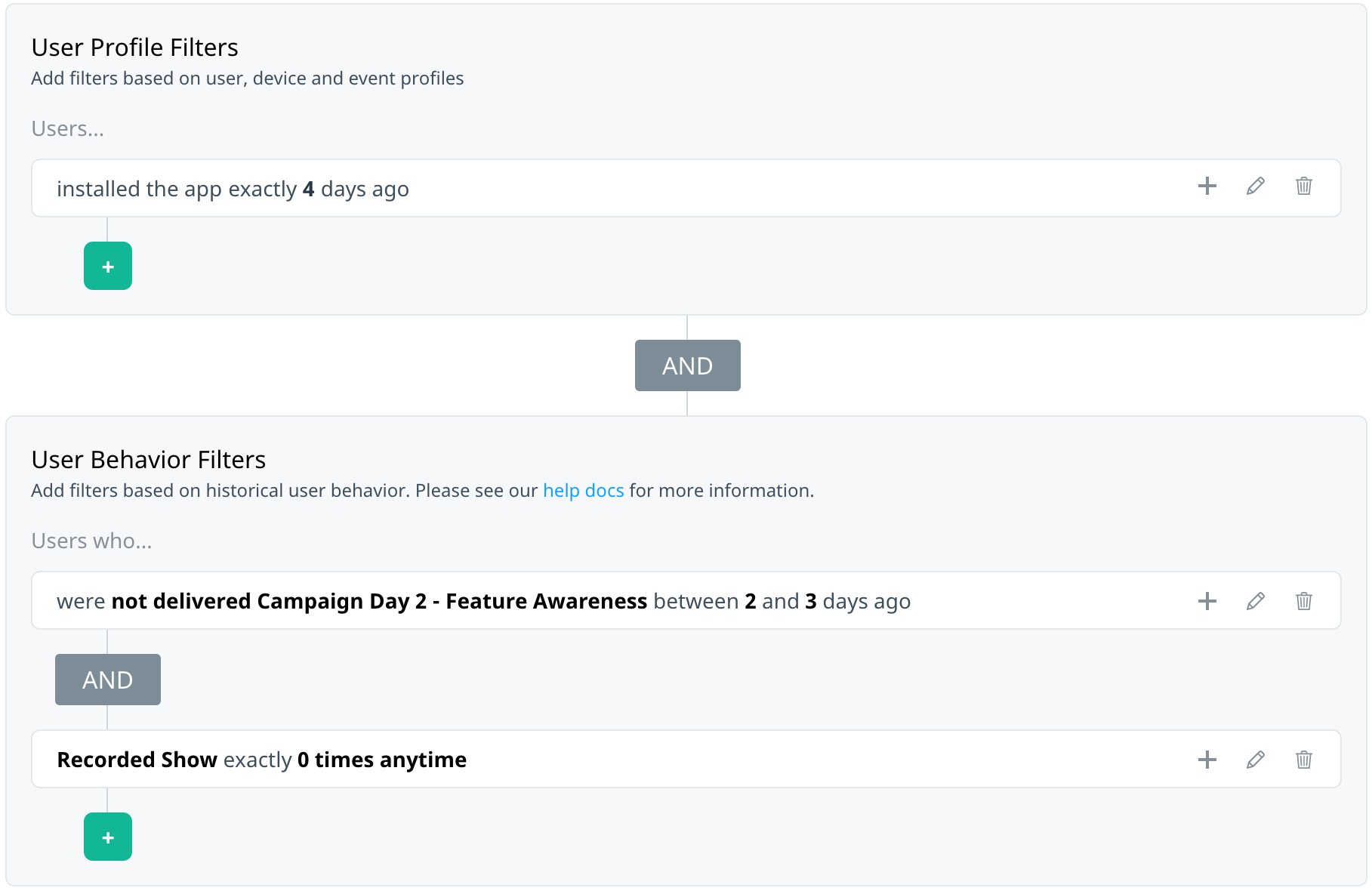How do I target my audience using recurring and push via API campaigns?
Our Custom Audience builder User Behavior filters now support audience targeting based on users’ push notification activities. This article explains how to use Swrve’s new campaign behavioral filters to target users based on their exposure to and interactions with recurring and push via API campaigns.
For an overview of the Campaigns filter options, see Targeting your audience by push notification events.
Targeting use cases
Ongoing campaigns support sending users the same push notification multiple times, depending on the target audience logic. Therefore, users might interact with the same campaign multiple times, in different ways. To account for this variety, the Campaign targeting filters include the option to specify recency and frequency criteria. The following examples show audiences you might create after selecting an ongoing campaign from the Campaign list.
Recurring push campaign activities
Example 1
For example, suppose you have an active recurring campaign that informs users about one of your app’s key features. The campaign is called Day 2 – Feature Awareness and sends the user a push notification two days after they install the app.
You might want to follow up with users who were not delivered the campaign within the last 2 to 3 days and who have not used the feature.
To create your target audience who were not delivered the push notification:
- On the Campaigns tab, select Specific Push Notification.
- In the campaign list, select your recurring campaign; for example, Day 2 Feature – Feature Awareness.
- In the Action list, select Not delivered.
- In the Recency list, select between (days ago) and enter the values 2 and 3 in the boxes.
- To save the filter definition, select Apply filter.
- Under the filter summary, select Add a new filter, and then define a payload filter to exclude users who have already used the feature you are promoting.
- To send the follow up campaign two days later, add a User Profile filter to target users who installed the app exactly 4 days ago.
Your completed target audience might look like the following:
Example 2
Perhaps you also want to follow up with the users who received the Day 2 – Feature Awareness push notification, with a campaign that highlights another one of your app’s key features.
To target users who received the push notification:
- Repeat steps 1 to 3 from Example 1, but select the Delivered action.
- In the Frequency list, select at least and enter 1 as the value.
- In the Recency list, select between (days ago) and enter the values 2 and 3 in the boxes. (In this case, the recency criteria alone dictates that Swrve sends the follow up push notification two days after delivering the original notification.)
- To save the filter definition, select Apply filter.
- As in Example 1, you might add a User Behavior filter to exclude users who have already used the highlighted feature.
Your completed target audience might look like the following:
Example 3
Suppose you have an active recurring campaign, Day 3 – Favorite Content. The push notification asks users to indicate their favorite type of content and offers three possible responses through custom buttons. Use the Campaign filters to target users based on the response they provide through the custom button. This function represents a great opportunity to target users based on their interests.
To target users based on the custom button they selected:
- On the Campaigns tab, select Specific Push Notification.
- In the campaign list, select your recurring campaign; for example, Day 3 – Favorite Content. As you hover over the campaigns in the list, the preview displays details of any custom buttons
- In the Actions list, select Clicked Button, and then in the Button(s) list, select Button 1.
- In the Frequency list, select at least and enter 1 as the value.
- In the Recency list, select anytime.
- To save the filter definition, select Apply filter.
Your completed target audience might look like the following:
Push notifications triggered via API
Suppose you have an Abandon Cart campaign where your external marketing cloud or backend system triggers a push notification via the Swrve Push API. Use the campaign filters to target users who received the campaign, but did not engage or complete a purchase.
To target users who received a push via API campaign:
- On the Campaigns tab, select Specific Push Notification.
- In the campaign list, select the relevant push via API campaign; for example, Abandon Cart.
- In the Action list, select Delivered but not engaged.
- In the Frequency list, select at least and enter 1 as the value.
- In the Recency list, select between (days ago) and enter the values 2 and 3 in the boxes. (The recency criteria dictates that Swrve sends the push notification 48 to 72 hours after receiving the original notification.)
- Using the User Behavior Payload filters, add criteria to exclude users who have not completed a purchase in the last three days.
Your completed target audience might look like the following:



